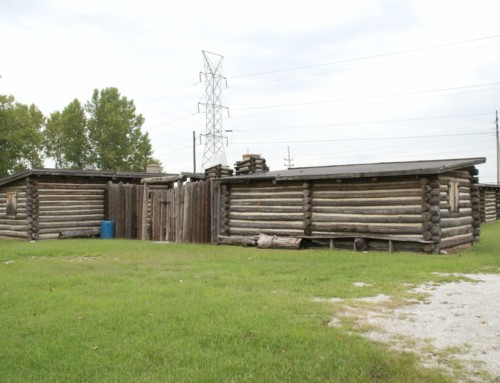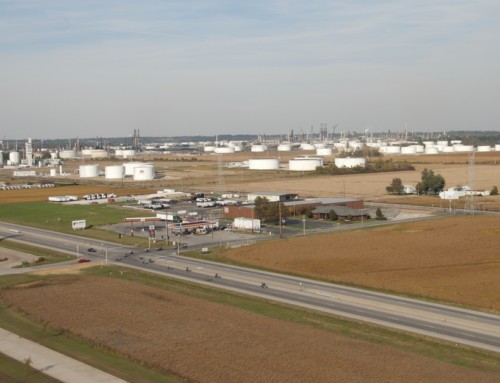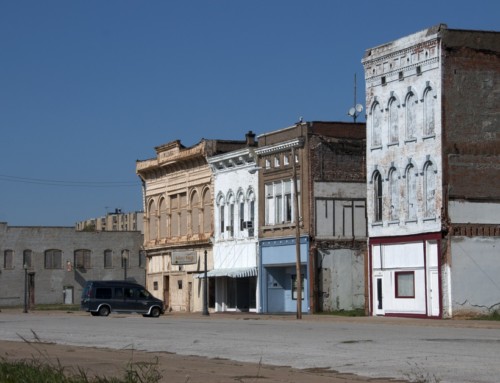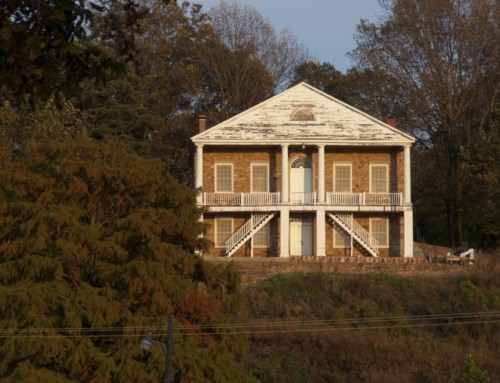Introduction
East Alton became a community primarily because of railroads and a large ammunition plant. The railroad tracks still carve up the city (which side of the tracks did you grow up on?), and that ammunition plant is still around, too.
History
Before Europeans began moving into the area, this part of Illinois was home to a confederation of Algonquin-speaking tribes known as the Illiniwek, which included groups like the Cahokia, Peoria, Kaskaskia, Mitchagamie, and Tamaroa. They lived in communities along the mid-Mississippi River and the Illinois River and dominated the region for centuries.
In 1809, Walter Seely and John Wallace laid out a town they called Milton along Wood River Creek. It grew to have two sawmills, a distillery, a pub, a store, and a grist mill. A dam on the creek provided power for the mills, but it also provided an ideal breeding group for malaria-carrying mosquitoes, which led to outbreaks of disease that led to the demise of the community by 1820. The land stayed mostly undeveloped for several decades after that.
In the mid-1800s, the Alton and Shawneetown Railroad and the Illinois and St. Louis Railroad built junctions in the area to transfer cars and cargo. A few Irish immigrants settled near the junction, so some people called the settlement Emerald. The railroads called the area Alton Junction or Wann Junction.
In the 1860s, the Western Fire Brick Company (which later became the Stoneware Pipe Company) built a factory near Wood River Creek. They made made pipe for chimneys and sewers, drain tiles, and flue linings from the clay next to the creek. The plant was destroyed by a flood in 1902 but rebuilt.
Tragedy struck the growing community in 1893. On January 21, a switch operator accidentally left a switch open at Wann Junction (near today’s intersection of Shamrock and Main Streets), which caused the Southwestern Limited passenger train to slam into a line of oil tankers. Only a few passengers were injured in the initial impact, but when the oil tankers exploded, burning oil erupted from the tankers and sprayed the immediate area. The engineer of the Southwestern Limited died quickly after being covered in burning oil, and dozens of others were mortally wounded or severely injured, including a bunch of people who wandered near the wreck to look at it.
The wreck happened just after Vermont-native Franklin Olin bought land in the area where he would build a factory to manufacture blasting powder. The Equitable Powder Manufacturing Company opened in 1893 and made a lot of money, which allowed Olin to expand to ammunition. In 1897, he built the Western Cartridge Company next door, which manufactured small arms; the factory employed 2,500 people normally. During World War II, Olin Corporation in East Alton employed 15,000 people. If you just happened to walk past the factory in the daytime, you could hear machine guns being tested.
With it growing industrial base, the community of 300 people decided to incorporate in 1893, settling on the name East Alton. Voters approved incorporation 41-1 with one voter disqualified.
During World War I, the East Alton stock yards were used to house and train horses for the war effort. Some 250,000 “war horses” were stationed in East Alton before being shipped to Europe to supply the armies of Britain, France, and Belgium.
East Altonians who wanted to go to Alton to shop or hang out could take a train known as the “Plug.” It made as many as 17 runs per day until it was shut down in 1939.
Acclaimed painter Alice E. Job grew up in East Alton. Born in 1859, she studied painting at Lindenwood College, then lived in Europe for a while to study in Paris. She left Paris and moved back home for three years, then traveled to Japan, where she studied Japanese techniques and painted cherry blossoms. She moved to China after that and spent the next 14 years living and traveling around China, Burma (Myanmar), and India. She even made a difficult trek to visit remote Tibet. She moved back to the US in 1919 and settled in New York City. Her paintings were quite popular, selling well getting displayed at prominent galleries. She died in 1945 at the age of 86.
East Alton is near the lower end of a series of locks and dams that were built on the Upper Mississippi River, a Depression-era public works program aimed to address complaints of Midwestern farmers and business interests who felt railroads were charging unfair rates for long-haul transport. The structures were built by the US Army Corps of Engineers entirely with federal tax dollars; all operations and maintenance costs were also covered by taxpayers.
By the mid-1950s, shipping interests began to lobby to upgrade lock and dam #26 at Alton, which had a single 600-foot lock and an auxiliary 300-foot lock. Barge traffic had been increasing and was forecasted to reach the lock’s capacity by the end of the 1960s. The Corps proposed a plan in 1968 that called for twin 1200-foot locks that looked like it was going to be built, but questions about the Corps’ authority to build a new structure slowed construction. In addition, the project was among the first federal projects that needed a thorough review of its potential environmental impact under the 1970 National Environmental Policy Act (NEPA) that President Nixon had signed.
After years of lawsuits and negotiations, Congress ultimately authorized a 1200-foot lock and a 600-foot auxiliary lock, as well as funding for habitat restoration around the impacted area. The process also resulted in another significant change; for the first time, shipping interests were required to pay for some of the costs of building the structures that make their work possible. A modest diesel fuel tax was passed in 1978 that was supposed to raise enough money to pay for half of the cost of new construction and major rehabilitation projects. In practice, taxpayers continue to pay for more than half of those costs, plus we also pay the full costs of routine maintenance and annual operations. None of the diesel fuel tax is used for restoring environmental systems damaged by shipping and the navigation structures; taxpayers also pay for all of those costs.
The new lock was named for Illinois Congressman Melvin Price, who helped secure the billion dollars in federal funding for the project. Since the main lock opened in 1989 at East Alton, commercial barge traffic has fallen far short of what the Corps and shipping interests projected. In 2016, for example, commercial traffic was only half of what the Corps predicted it would be.
Exploring the Area
The East Alton History Museum (211 N. Shamrock; 618.216.2781; Th,F 1-4, Sa 10-1) focuses on the community that grew up around the Western Cartridge Company, now Winchester Ammunition.
The National Great Rivers Museum at the billion-dollar Mel Price Locks and Dam (2 Lock & Dam Way; 877.462.6979) showcases the history of navigation on the Mississippi River; guided tours take visitors all the way to the top of the structure.
**The area around East Alton is covered in Road Tripping Along the Great River Road, Vol. 1. Click the link above for more. Disclosure: This website may be compensated for linking to other sites or for sales of products we link to.
Resources
- East Alton Public Library: 250 Washington Ave.; 618.259.0787.
- Post Office:200 Smith Ave.
Where to Go Next
Heading upriver? Check out Alton.
Heading downriver? Check out Wood River.
Community-supported writing
If you like the content at the Mississippi Valley Traveler, please consider showing your support by making a one-time contribution or by subscribing through Patreon. Book sales don’t fully cover my costs, and I don’t have deep corporate pockets bankrolling my work. I’m a freelance writer bringing you stories about life along the Mississippi River. I need your help to keep this going. Every dollar you contribute makes it possible for me to continue sharing stories about America’s Greatest River!
©Dean Klinkenberg, 2018





